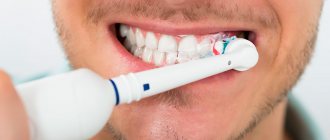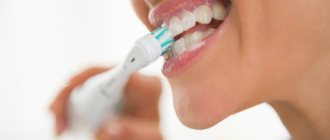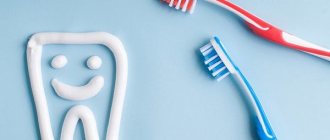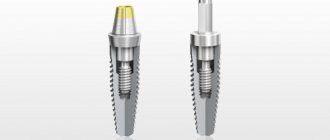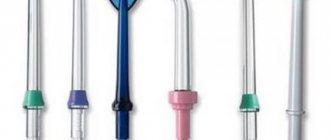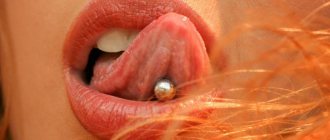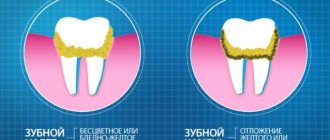There are a huge number of electric brushes on the market, which differ from each other in their operating principles and functions. Ultrasonic brushes are considered the most modern. They operate on the basis of ultrasonic waves that are transmitted from the device to the person during cleaning. We'll tell you how to brush your teeth with this brush.
An ultrasonic toothbrush uses ultrasonic waves to cleanse teeth from food debris and plaque. This device consists of a handle with a battery or battery, a body equipped with a high-frequency generator, and a head with bristles, like a regular toothbrush.
In this article
- Working principle of an ultrasonic toothbrush
- Ultrasonic brush: indications and contraindications
- Ultrasonic brush: pros and cons
- How to brush your teeth with an ultrasonic brush
- How to choose an ultrasonic brush
- How to care for an ultrasonic toothbrush
Ultrasound devices are the most modern and functional. They provide maximum cleansing of the oral cavity, including interdental spaces, and removal of plaque and deposits. With this device, many dental diseases can be prevented. Let's talk about the features of ultrasonic brushes and learn how to properly brush your teeth with them.
Working principle of an ultrasonic toothbrush
When using an ultrasonic brush, teeth are cleaned using both bristles and high-frequency waves. The bristles clean the enamel from surface contaminants, just like a regular toothbrush. You just don’t need to put pressure on your teeth or rub them with the device. It is necessary to move the head from one part of the jaw to another, lingering in each area for a few seconds.
Ultrasonic waves created by the device penetrate deep into deposits, destroying them from the inside. They are separated from the enamel and washed out of the mouth. At the same time, the mouth is cleansed of germs. You may feel warm while cleaning. As a result of an increase in temperature by 1°, blood flow in soft tissues is stimulated, as with a light massage, which reduces their sensitivity and prevents the development of gingivitis. In addition, calcium and fluoride ions are released from toothpaste, which strengthen the enamel.
Using an ultrasonic brush, you can maintain oral hygiene without resorting to other means: balms, dental floss, etc.
Research results
Current research indicates a slight advantage to electric toothbrushes. Adults and children who used a power brush to clean their mouths showed an 11 percent reduction in plaque on their teeth and were less likely to experience gingivitis and other gum diseases than people who used a manual toothbrush.
Additionally, the researchers found that brushes with small round heads that spin quickly in one direction and then the other did a slightly better job of removing plaque than brushes with oval heads that move quickly or vibrate from side to side. But the study authors say more research is needed to confirm these results.
Another study found that using an electric toothbrush reduced the progression of periodontal disease. Additionally, power toothbrush users had healthier gums overall and 19 percent more teeth over the study period than those who used manual brushes.
However, you can effectively brush your teeth with a regular manual toothbrush.
Ultrasonic brush: pros and cons
Brushing your teeth with an ultrasonic brush is useful for the following reasons:
- removes bacteria from the mouth;
- destroys plaque;
- suitable for sensitive gums and enamel;
- compatible with braces and dentures;
- stimulates blood circulation.
There are practically no disadvantages to such devices, except for the presence of contraindications and high price. However, you can use one brush with your whole family if everyone has their own brush head. Accessories must be purchased separately. In addition, any doctor will tell you that it is better not to skimp on oral hygiene. We'll tell you how to properly brush your teeth with an ultrasonic brush.
When an ultrasonic brush will not cause harm –
- when there are no fillings, crowns, veneers, etc. on the teeth.
- when you do not have dental plaque (especially subgingival plaque),
- when you do not have gingivitis, periodontitis, untreated teeth,
- with periodontal disease.
Periodontal disease differs from periodontitis and gingivitis in that bone resorption during periodontal disease is not associated with inflammatory changes in the gums, but with processes of tissue degeneration (without any signs of inflammation). In this case, improving blood microcirculation in the gums can be beneficial. However, in 99.99% of cases, gum disease in people is associated precisely with insufficient hygiene, infection and inflammation, and not dystrophy.
How to brush your teeth with an ultrasonic brush
You need to learn how to use any toothbrush, otherwise it will be of no use. In addition, there is a risk of injuring soft tissues or enamel. Read the instructions before using the device. To properly brush your teeth with an ultrasonic electric brush, you need to follow the following algorithm:
- select the appropriate operating mode;
- rinse the bristles with water;
- apply a little paste on them;
- bring the brush to the front row of teeth at an angle of 45°;
- carefully move the head along the jaw without pressing on it;
- brush each tooth for 3-4 seconds;
- Rinse your mouth with water and wash your brush.
The duration of the procedure is 2-3 minutes. Some devices have a timer that alerts you when you need to move to the next quadrant of the jaw or finish brushing.
Depending on the specific model, the device can operate in several modes. They differ in the number of movements of the bristles. At the very beginning, choose a mode with minimal vibration intensity. When switching them, turn off the device.
Cautions for using an electric toothbrush
- People with thin tooth enamel and particularly sensitive gums are not recommended to use an electric brush; however, manufacturers already offer models with pressure sensors that prevent the enamel from depleting and are gentle on the gums.
- It is strictly not recommended to use electric toothbrushes for people with wedge-shaped dental defects, which increase nerve sensitivity, and for children under three years of age.
- Many dentists advise using an electric toothbrush only once a day and using a regular manual toothbrush the rest of the time.
- Do not leave the brush on the charging base that is always on - this will drain the battery faster.
Sources:
- https://tehcovet.ru/reitingi/krasota-i-yhod-reitingi/luchshie-ultrazvukovye-zubnye-shhetki-2019-goda.html
- https://dentamed.club/gigiena/elektricheskie-zubnye-shhetki/ultrazvukovye-reyting-2018-2019.html
- https://tehnolev.ru/dlya-zdorovya/zubnaya-schetka/kak-pravilno-vybrat-i-top-10-luchshih-ultrazvukovyh-zubnyh-schetok.html
- https://tech-choice.net/luchshie-jelektricheskie-zubnye-shhetki/
How to choose an ultrasonic brush
When buying an electric toothbrush, pay attention to the following parameters:
- Number of modes. The more there are, the safer and better the device cleans the oral cavity.
- Pressure sensor. If you press hard on your teeth with the brush, the device will automatically turn off.
- Timer. It makes it easier to get used to brushing your teeth with an electric brush. It is advisable to buy models with timers for children.
It is also necessary to choose the right nozzle. There are several types of ultrasonic toothbrushes available:
- MB1 (soft) - a nozzle with soft bristles of a zigzag shape. It is suitable for children, people with hypersensitivity of enamel and gums, as well as for pathologies of the soft tissues of the oral cavity.
- MB2 (medium) - a brush with medium-hard bristles in a zigzag shape. It can be used by all people with healthy teeth and gums.
- MB5 (soft) - a nozzle with soft bristles of equal height. It is better to choose it if there is bleeding gums, as well as after dental operations.
- MB6 (medium) - a brush with medium-hard bristles with equal hairs along the entire length. It is recommended for people with crowns and veneers.
There are not as many ultrasonic models today as standard and sound ones. Our online store presents a series of Emmi-Dent ultrasonic electric brushes. They operate on batteries and can hold a charge for 20 days.
What to prefer?
There is no definite answer to this question, since everything depends on the condition of the patient’s oral cavity. For example, with healthy teeth that are prone to mineralization of plaque, you can use an ultrasonic electric brush, which is effective in preventing the formation of tartar. And if you have fillings, it is better to choose a sonic or mechanical brush. That is why the final decision to purchase a particular model is made individually, after consultation with a dentist.
Liked? Tell your friends!
How to care for an ultrasonic toothbrush
Such devices are quite expensive, so they need to be carefully looked after so that they last as long as possible. After each procedure, rinse the bristles to remove food debris and bacteria. You can pour boiling water over the head or periodically rinse it in a disinfectant solution. Keep the device in a place protected from water. Do not allow moisture to get on the motor, as it may burn out. Do not charge your device in the bathroom. It is better to do this in the room or kitchen.
Every 3-4 months it is necessary to change the attachments. Over time, they delaminate, move apart and soften. It is not safe to use such a brush. Some models have a wear indicator - blue bristles. Over time, they fade, which indicates the need to throw away the old attachment and connect a new one to the device.
Electric toothbrushes: myths and reality
Electric toothbrushes are steadily gaining space on many people's bathroom shelves, and it's no coincidence. Thanks to a number of positive properties, these brushes have a lot of enthusiastic reviews from users. However, there are persistent myths about the dangers of electric brushes. We will try to find out whether they are related to the truth.
It should be noted that electric toothbrushes come in rotary, sonic and ultrasonic types. We will take a closer look at sonic brushes.
Myth 1: Electric toothbrushes are not suitable for people with sensitive teeth and gums.
The myth that electric brushes cause bleeding gums and prematurely wear away enamel has been completely debunked by numerous clinical studies. For example, electric sonic toothbrushes are not only not prohibited, but are also recommended for people with hypersensitive teeth and bleeding gums.
When used correctly, an electric toothbrush with sonic technology only needs to lightly touch the teeth and the edge of the gums. This will clean your teeth of plaque and lightly massage your gums, improving their blood flow.
Also, within the framework of this myth, it is argued that such brushes cannot be used constantly, but should be alternated with a regular manual brush. This myth is not true. In fact, electric toothbrushes are great for regular use.
Myth 2: Electric toothbrushes destroy fillings
Electric toothbrushes with sonic technology do not destroy fillings. Although such brushes make a large number of movements per minute, they do not put pressure on the teeth and gums. The force with which the brush presses on the teeth is entirely up to the conscience of the person brushing the teeth. Therefore, the recommendations indicate that you should brush your teeth by lightly touching the surface of the teeth and the edge of the gums.
The filling can break down over time if tooth decay develops underneath it. Most often, fillings fall out while eating or brushing teeth – hence such myths.
Myth 3: Children should not use electric toothbrushes.
Electric toothbrushes can be used by children. There are entire lines of toothbrushes created specifically for children, taking into account their needs and characteristics. Clinical studies confirm the safety of electric toothbrushes.
It is important to note that many dentists recommend electric toothbrushes for children, as they help children brush their teeth much better. The secret is that you need to be able to brush your teeth with a manual brush. It is necessary to make sweeping movements from the gum to the edge of the tooth, paying special attention to hard-to-reach places. For kids, these activities are complicated and uninteresting. And, for example, children's electric brushes with sound technology CS Medica Kids and Junior do not require such difficulties. In addition, they have a bright design and LED lighting.
Myth 4: You can't use electric toothbrushes while wearing braces.
During orthodontic treatment, you can use an electric toothbrush.
It is important to consider that when wearing braces, special hygiene is required and an electric toothbrush with sonic technology is also recommended for use.
Myth 5: Electric toothbrushes are contraindicated for pregnant women
Electric toothbrushes with sonic technology for pregnant women are absolutely harmless. In addition, many women experience a number of problems with teeth and gums associated with hormonal imbalance. Using electric toothbrushes will help perfectly clean your teeth of plaque, massage your gums, and prevent the occurrence of gingivitis, a common disease among pregnant women.
Myth 6: The whole family can’t share the same electric toothbrush.
Can! If we are talking about a toothbrush with replaceable heads. For example, an electric sonic toothbrush for the whole family CS Medica CS-233-uv. The brush set includes several replaceable heads, marked in different colors. Also included is an ultraviolet disinfectant. There is no reason to doubt the hygiene of this brush.
Tips for using electric models
- Be sure to fully charge the device before using it for the first time. This may take several hours.
- Change brush heads every three months or sooner (if bristles become deformed).
- Use the brush until it is completely discharged. It is not recommended to recharge it between procedures: this may shorten the battery life.
- Rinse the brush head thoroughly with the mode on after each use.
- To avoid toothpaste splashing, first bring the brush to your teeth and then turn it on.
- During the first days of use, you may notice slight bleeding from your gums. If this phenomenon continues for several weeks, consult your dentist.
As for the widespread opinion that electric models are unsafe for enamel, this is not entirely true. It is not the brushes that spoil the enamel, but the incorrect cleaning technique. You can damage your teeth and gums with a regular brush if you press it hard and move it chaotically. Electric models should be used carefully, without pressing: just bring the brush to the surface of the teeth, smoothly moving it from one area to another. She will do all the rest of the work for you. Before purchasing such an expensive item as an electric toothbrush for yourself and your child, be sure to consult with the specialists of the Center for Modern Dentistry. Then you will not spend your money in vain, and your new acquisition will serve you faithfully for the health of the whole family.


